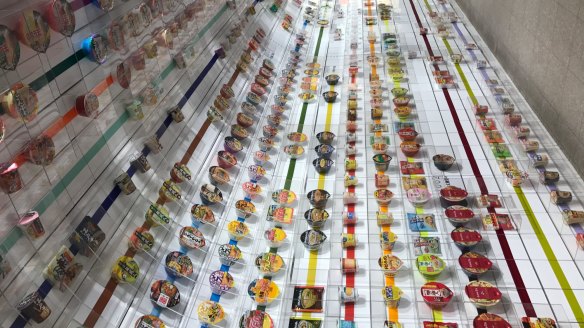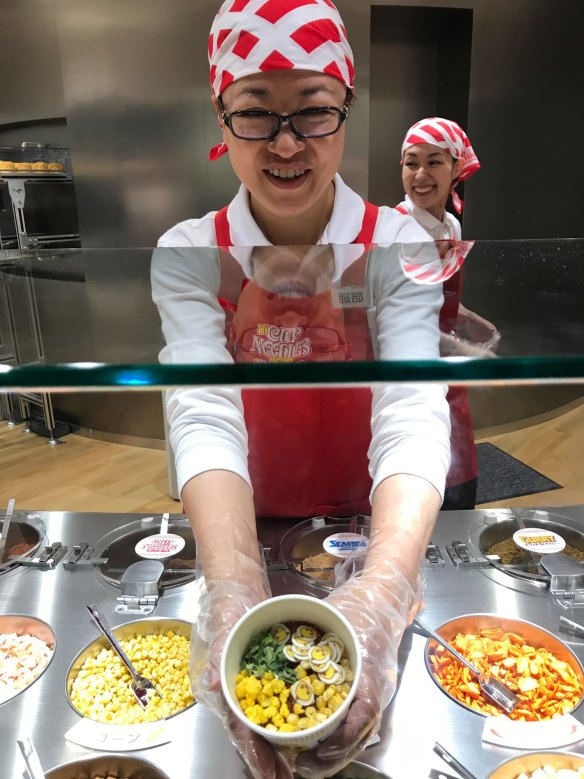Personalise your instant noodles at Japanese ramen mecca in Osaka

Should you decide to make a list of the cultural attractions around the globe that you would most like to visit, the chances are that Osaka's Momofuku Ando Instant Ramen Museum won't be in the top 10.
And that's a pity, because the massive, forbidding, almost martial building situated in the city's Ikeda district constitutes not only one of Japan's weirder museums, but also one of the most fun.
Osakans in particular, and the Japanese in general, are justly proud of the fact that in 1958 an entrepreneur called Momofuku Ando invented the instant noodle.

Given the purely functional, uber-cheap, bottom-of-the-barrel reputation of instant noodle meals – "pour in boiling water and wait for three minutes" hardly carries the cachet or challenge of a Ferran Adria recipe – it's easy to overlook the culinary revolution Mr Ando ushered in.
Arguably, there isn't a supermarket or corner store anywhere in the world that does not have at least one shelf – and, more likely, a whole wall – given over to cup noodles, with many of the brands on display manufactured by Mr Ando's company, Nissin Food Products.
To put this in perspective: according to the World Instant Noodle Association (yes, there is such a thing) in 2016 sales topped 97.46 billion units. (Honestly, sliced bread wishes it was a dried noodle.)
Momofuku Ando's career has been transformed into a real, information-packed, narrative-driven experience.
The Instant Ramen Museum, thus, is a place of global significance, and from the outside its sheer walls, thin vertical slit windows and po-faced larger-than-life statue of Mr Ando (who died in 2007, aged 96) exude appropriate seriousness and restraint.
Inside, however, is another matter. Here, the massive scale of Mr Ando's achievement is joyfully underscored by the Japanese love of bright colours, cute mascots, anime and generally over-the-top display.
This last quality becomes apparent the moment you enter the cathedral-like Hall of Noodles, which features thousands of dried ramen packets displayed with geometric precision in serried, chronological ranks extending up one towering wall and around the curved ceiling above.
Other display areas feature an enormous cup of noodles, surgically dissected to reveal its contents; life-size white mannequins demonstrating various scenes in Mr Ando's journey from struggling street-hawker to multi-millionaire philanthropist; an animated movie depicting the manufacturing process; and a holographic cauldron of boiling vegetable oil.
All of which is fun, but the element guaranteed to delight adults and children alike is the opportunity to create your very own personalised cup of instant noodles – sealed, shrink-wrapped, and secured in a strange do-it-yourself inflatable bag.
Visitors are invited – for 300 yen (around $4) – to select an empty cup and then decorate it using felt-tip pens. A sheet of cute yellow baby chicken drawings is provided, should you be lacking in inspiration.
Having completed the design, you then take your cup to the large, glass-walled kitchen zone, where very helpful people wearing noodle costumes will invite you turn production-line cranks, select from a range of dehydrated flavour ingredients – including shrimp, kimchi, garlic chips and roast pork – and choose a powdered sauce.
The kitchenhand will then put your cup through the sealing and shrink-wrapping process, pausing at appropriately Instagrammable moments, before handing the final sterilised result over and pointing you to where inflatable bags and disposable straws await.
Entry is free, and reaching the place – two trains from Shin-Osaka station – is simple and costs around five bucks per person. All up, therefore, it's possible to spend a surprisingly enjoyable and memorable couple of hours for under a tenner. Plus you get to keep the noodles.
For all its gimmickry, Momofuku Ando's career has been transformed into a real, information-packed, narrative-driven experience – which is more than can be said, frankly, for other places in Osaka that style themselves as food-themed museums.
Indeed, after visiting the Gourmet Museum at Umeda and the Food And Drink Museum at Shin-Osaka station one could be forgiven for concluding that, in Japanese, "museum" is a synonym for "food court".
That said, visitors might still find fun in a brief visit to the Osaka Takoyaki Museum in the district of Shimaya. This is especially so if you're planning to also visit the Universal City theme park, the entrance to which is nearby.
Takoyaki is an iconic part of Osaka's street food cuisine: a ball of fried wheat-flour batter containing chopped up bits of octopus, drenched in barbecue sauce or mayonnaise and served in cardboard containers in multiples of eight.
They are delicious and plentiful, especially around the city's bustling and cosmopolitan Namba district.
The museum, oddly enough, is a long way away from takoyaki central, positioned upstairs in a sleek, modern multi-story shopping district otherwise occupied by chain restaurants and souvenir shops.
Those seeking insight into the history of octopus balls will find little of value.
However, the place is great fun, comprising five competing takoyaki cafes, a takoyaki-themed gift shop (plush octopus, anyone?), takoyaki-themed vending machines, and outrageously large and bright fibreglass anthropomorphic models of octopi, happily alive and even more happily cooked.
And the takoyaki balls themselves, it has to be said, are delicious – well-sauced, chewy, hot and made to order, with no attempt made to dumb them down for Western tourists who drop by before or after the horrors of the theme park. (If after, by the way, take note that beer is available.)
Momofuku Instant Ramen Museum instantramen-museum.jp/en/
Osaka Takoyaki Museum ucw.jp/otm/ (Japanese); osaka-info.jp/en/gourmet/takoyaki_okonomiyaki/post_33.html (English)
Where to eat in Osaka
Kura Sushi
Easy to miss, perched above a parking lot, Kura Sushi is an almost fully automated sushi joint. High volume stuff passes by on a conveyor, special orders are made via iPads and arrive on high-speed trays running along rails. There's even a machine that pours pints of beer. Most dishes are 100 yen.
1-8-23 Shikitsuhigashi, Naniwa-ku
Kushikatsu Sakura
Kushiage cooking – essentially deep-fried, battered things on skewers – is an Osaka speciality. This little restaurant is tucked away in a covered alley next to the city's "kitchen street" (Sennichimae Doguyasuji), where chefs and hospo folk come to shop. In such an environment it needs to be good – and it is.
9-12 Nanbasennichimae, Chuo-ku
The takoyaki stalls of Namba
The crowded streets and canals of the Namba district are crammed with stalls and tiny restaurants offering delicious takoyaki balls, cooked on the spot and served hot and sauce-drenched in cardboard containers. Look for giant fiberglass octopi on the walls, or just join the end of a queue.
Akagakiya Kaitenzushi
Another little conveyor-belt sushi bar – this one with chefs highly visible in a central open kitchen – in another covered alley. Blink and you'll miss it. Try to find it for a second visit and you probably won't. Delicious, ultra-fresh fish, washed down with an ice-cold pint of Asahi. Perfect.
3 Chome-1-16, Nanba
Sobayoshi
Old, unfussy and elegant, this is a locals' eatery that makes few concessions to travellers – except, of course, faultless courtesy. The menu is small, but its cold soba dishes are excellent, and its unagi (eel) on rice is to die for.
2-9-13 Motomachi, Naniwa-ku
Restaurant reviews, news and the hottest openings served to your inbox.
Sign up